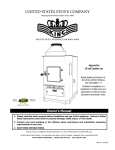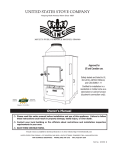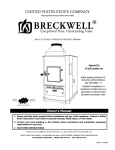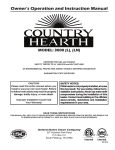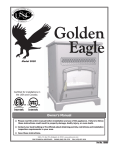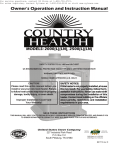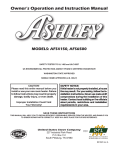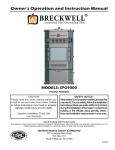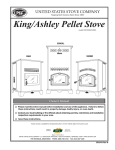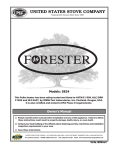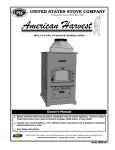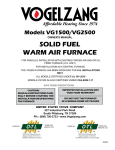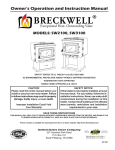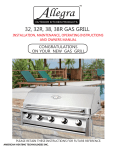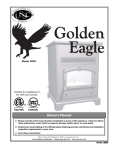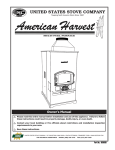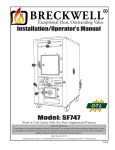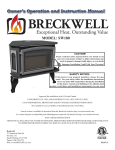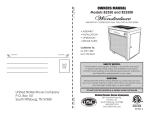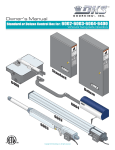Download United States Stove Company 8500 Owner`s manual
Transcript
For service questions, contact US Stove at 1-800-750-2723. For sales inquiries, contact Sylvane at 1-800-934-9194 or visit www.sylvane.com. UNITED STATES STOVE COMPANY “Keeping North America Warm Since 1869” MULTI-FUEL FURNACE MODEL 8500 Approved for US and Canadian use. Safety tested and listed to UL 391-2010, ASTM E1509-04, and CSA-B366.1-11 Certified for installation in a residential or mobile home as a stand-alone or add-on furnace (ductwork connection only). TESTED & LISTED BY PORTLAND, OREGON, USA Report #: 215-S-22b-2 Owner’s Manual Please read this entire manual before installation and use of this appliance. Failure to follow these instructions could result in property damage, bodily injury, or even death. Contact your local building or fire officials about restrictions and installation inspection requirements in your area. SAVE THESE INSTRUCTIONS. French version is available for download from the U. S. Stove website: http://www.Breckwell.com/ UNITED STATES STOVE COMPANY • 227 INDUSTRIAL PARK ROAD • SOUTH PITTSBURG, TENNESSEE 37380 • WWW.USSTOVE.COM FOR TECHNICAL ASSISTANCE: PHONE: (800) 750-2723 FAX: (423) 837-2109 USSC1 Part No.: 851976 Table of Contents TABLE OF CONTENTS............................................................................................... 2 Safety Precautions............................................................................................ 3 Specifications........................................................................................................ 4 Heating Specifications...................................................................................... 4 Dimensions....................................................................................................... 4 Electrical Specifications.................................................................................... 4 Safety and EPA Compliance............................................................................. 4 Fuel Considerations.......................................................................................... 5 Installation ........................................................................................................... 5 Installation Options........................................................................................... 6 Floor Protection................................................................................................ 6 Clearances ....................................................................................................... 7 Venting Requirements...................................................................................... 8 Maximum Venting Distance.............................................................................. 8 Pellet Vent Type................................................................................................ 8 Pellet Vent Installation...................................................................................... 8 Pellet Vent Termination..................................................................................... 8 Vent Termination Clearances............................................................................ 9 Through the Wall Installation.......................................................................... 10 Through the Roof/Ceiling Installation............................................................. 10 Primary and Secondary Furnace Illustrations................................................. 11 Operation.............................................................................................................. 12 How Your Furnace Works............................................................................... 12 Damper Control Adjustment............................................................................ 12 Control Panel.................................................................................................. 13 Unit Preparation.............................................................................................. 14 Start-Up Procedure......................................................................................... 14 Shut Down Procedure..................................................................................... 14 Daily Operation............................................................................................... 15 Safety and Convenience Features................................................................. 15 Maintenance......................................................................................................... 15 Exhaust System.............................................................................................. 15 Interior Chambers........................................................................................... 16 Ash Disposal................................................................................................... 16 Hopper Cleaning............................................................................................. 16 Main Door Gaskets......................................................................................... 16 Fan Motors...................................................................................................... 16 Painted Surfaces............................................................................................ 16 Glass............................................................................................................... 16 Fall Start-Up.................................................................................................... 16 Spring Shut Down........................................................................................... 16 Yearly Servicing.............................................................................................. 16 Repair Parts DIAGRAM & List......................................................................17-18 Wiring Diagram.................................................................................................... 19 Trouble Shooting.............................................................................................. 20 Error codes......................................................................................................... 21 Flashing indicators.......................................................................................... 21 notes..................................................................................................................22-23 2USSC Safety Precautions IMPORTANT: Read this entire manual before installing and operating this product. Failure to do so may result in property damage, bodily injury, or even death. Proper installation of this furnace is crucial for safe and efficient operation. Contact your local building officials to obtain a permit and information on any additional installation restrictions or inspection requirements in your area. DO NOT throw this manual away. This manual has important operation and maintenance instructions that you will need at a later time. Always follow the instructions in this manual. Never try to repair or replace any part of the furnace unless instructions for doing so are given in this manual. All other work should be done by a trained technician. Install appliance and venting at clearances specified in this manual. DO NOT connect the pellet exhaust vent to a vent serving any other appliance or furnace. DO NOT install a flue damper in the exhaust venting system of this unit. Use of outside air is not required for this unit, but is highly recommended. If installed into a tightly constructed home, (Mobile Home) a fresh air opening of at least 2 in. diameter (150mm) into the room where the unit is installed is required. However return air make-up is required for maximum heat distribution throughout your home. This heater is designed and approved as a multi-fuel (corn or wood pellets) furnace. Use only dried shelled corn with a moisture content of 11% or less (which provides the best results). Pellet fuel used should have an ash content of 1% or less. If not, performance and efficiency of the unit will suffer, and your warranty may be voided. Never use gasoline, gasoline-type lantern fuel, kerosene, charcoal lighter fluid, or similar liquids to start or ’freshen up’ a fire in this furnace. Keep all such liquids well away from the furnace while it is in use. A working smoke detector must be installed in the same room as this product. DO NOT unplug the furnace if you suspect a malfunction. Turn the ON/OFF SWITCH to ”OFF’ and contact your dealer. Your furnace requires periodic maintenance and cleaning (see ”MAINTENANCE ”). Failure to maintain your furnace may lead to improper and/or unsafe operation. DANGER: Risk of Fire or Explosion - DO NOT BURN GARBAGE, GASOLINE, NAPTHA, ENGINE OIL, OR OTHER INAPPROPRIATE MATERIALS. Disconnect the power cord before performing any maintenance! NOTE: Turning the ON/OFF Switch to ”OFF” does not disconnect all power to the electrical components of the furnace. Allow the furnace to cool before performing any maintenance or cleaning. Ashes must be disposed of in a steel container with a tight fitting lid. The closed container of ashes should be placed on a noncombustible surface or on the ground, well away from all combustible materials, pending final disposal. The exhaust system should be checked monthly during the burning season for any build-up of soot or creosote. Creosote in your exhaust can potentially cause a chimney fire. In the event of a chimney fire, contact your fire department immediately and press the “OFF” button on your furnace. Have a clearly understood plan to handle a chimney fire. CAUTION: Keep children away. Do not touch during operation. Educate all children on the dangers of a high-temperature furnace. Young children should be supervised when they are in the same room as the furnace. A power surge protector is recommended. This unit must be plugged into a 110 - 120V, 60 Hz grounded electrical outlet. Do not use an adapter plug or sever the grounding plug. Do not route the electrical cord underneath, in front of, or over the furnace. Do not route the cord in foot traffic areas or pinch the cord under furniture. The furnace will not operate during a power outage. If a power outage does occur, check the furnace for smoke spillage and open a window if any smoke spills into the room. The feed door and ash pan must be closed and sealed during operation to keep products of combustion from escaping the furnace. Keep all seals in good condition. Never block free flow of air through the open vents of the unit. Keep foreign objects out of the hopper. The moving parts of this furnace are propelled by high torque electric motors. Keep all body parts away from the auger while the furnace is plugged into an electrical outlet. These moving parts may begin to move at any time while the furnace is plugged in. Do not place clothing or other flammable items on or near this furnace. This appliance is not intended for commercial use. WARNING: DO NOT INSTALL IN SLEEPING ROOM. CAUTION: THE STRUCTURAL INTEGRITY OF THE MANUFACTURED HOME FLOOR, WALL, AND CEILING/ROOF MUST BE MAINTAINED. USSC3 Specifications SHELLED CORN (Dry, preferably corn with 11% or less moisture content) Heating Specifications Input BTU/Hr1 50,000 to 105,000 BTU/hr. Heating Capacity2 1,200 - 2,800 sq. ft. Fuel Burn Rate 5.0 - 13.0 lbs./hr. 3 Fuel Considerations Burn Time (lowest setting) 70 hours continuous Hopper Capacity 320 lbs BTU output will vary depending on the quality and type of fuel. Use PFI listed fuels for the best results. Heating capacity will vary depending on floor plan layout of your home, degree of insulation, and the outside temperature. 3 Fuel size may effect the actual rate of fuel feed and burn times. Fuel feed rates may vary by as much as 20%. Use PFI listed fuel for best results. 1 • Optimum moisture content of corn should be 11% or less. Wet corn will rapidly deteriorate furnace components, reduce efficiency and void all warranties. Purchase a moisture tester if in doubt. • Corn must be clean and free from debris. Never burn corn right from the field. Damage caused by dirty corn is not covered by the product warranty. Ask for clean filtered, bagged corn only. Stalk parts, excessive fines and cob remnants will clog the auger. • NEVER BURN SEED CORN IN YOUR FURNACE. Seed corn is treated with chemical pesticides that are harmful or fatal if swallowed, therefore, seed corn is dangerous to have in the house, especially where children can reach it. • Never burn “Deer Corn.” It frequently contains molasses/sugars. • Store your corn supply in a dry place and keep bags or container sealed to prevent your corn from absorbing excess moisture. Test the moisture content periodically to ensure proper dryness. • There are many varieties of corn grown around the world. Each variety has unique characteristics including the shape and size of the kernel. Your furnace will burn more consistently with a small to midsize kernel corn. If the kernel size of the corn varies greatly or if you switch sources frequently, you will get a less consistent burn. Therefore, purchasing corn from the same source will help achieve a more consistent burn. DO NOT USE CORN WITH A HIGH WAX CONTENT! • Oyster shell is highly recommended for best burn operations and to reduce clinker build-up 2 Dimensions Height 43 in. [109cm] Width 28-1/2 in. [72.4cm] Depth 45 in. [114cm] Weight 250 lbs. WOOD PELLETS Electrical Specifications Electrical Rating Watts (operational) 110-120 volts, 60 HZ, 9.5 Amps 1150 (max. approx.) SAFETY AND EPA COMPLIANCE • As with corn, be consistent with your pellet supplier. Pellets will vary in content and burn characteristics from supplier to supplier. A consistent supply of pellets will result in a more consistent and efficient burn. • Check your pellets for foreign objects. Your furnace warranty will not cover damage done to your furnace due to foreign objects in the fuel supply. • Store your pellets in a dry place to prevent them from absorbing added moisture. • To decrease sawdust buildup, the hopper will need to be vacuumed out after every 6-8 bags of pellets or more often if the pellets are poor quality. You may have to screen-sift each bag of pellets if sawdust becomes a problem. • Wood Pellets vary in size and ash content from less than 1% to 3% or more. Your furnace will burn more efficiently with small to midsize pellets. Low ash content pellets will allow you to burn the furnace longer between cleanings. Only wood pellets manufactured to the Pellet Fuel Industries (P.F.I.) standard for residential pellet fuels are recommended. Performance will suffer if nonstandard pellets are used. Consult your local King reseller for more information on approved wood pellet fuel. If fans are used in the fuel storage area, they should be installed so as not to create a negative pressure in the room where your furnace is located. Your King Furnace has been safety tested and listed to UL 391-2010, ASTM E1509-04, and CSA-B366.1-11, by OMNITest Laboratories, Inc. Portland, Oregon USA. It is also exempt from EPA Phase II requirements. CAUTION: DO NOT PLACE SUCH FUELS WITHIN THE SPACE HEATER’S INSTALLATION CLEARANCES OR WITHIN THE SPACE REQUIRED FOR REFUELING AND ASH REMOVAL. 4USSC USSC5 Installation Installation Installation Options Read this entire manual before you install and use your Multi-Fuel Furnace. Failure to follow instructions may result in property damage, bodily injury, or even death! (See specific installation details for clearances and other installation requirements) Certified for installation in a Residentail Type home in the USA and Canada. Also may be installed into a Manufactured or Mobile Home. Clearances NOTE: Distance on the left-hand side of your Multi-Fuel Furnace is set at 24 inches for suitable access to the control panel and for fuel loading. This distance may be less, but not less than 7 inches. As a Primary Furnace—the unit functions independently of any other system. The “Room Air” blowers will come on when the plenum and exhaust temperatures reach a preset point programmed into the furnace’s circuit board (PCB). Unit may also be used as a stand-alone shop heater. This is the only approved installation configuration in which ductwork or return air is not required. All other configurations utilizing a ductwork system must supply return air to the appliance. As a Secondary (Add-On) Furnace—the unit aids an existing gas/electric furnace helping cut down on operation time. It is recommended that only a authorized technician install your Multi-Fuel Furnace, preferably an NFI certified specialist. Canada requires that the installation of the pellet-fuel furnace shall comply with the applicable requirements of CSA-B365. IMPROPER INSTALLATION: The manufacturer will not be held responsible for damage caused by the malfunction of a furnace due to improper venting or installation. Call (800) 750-2723 and/or consult a professional installer if you have any questions. ADDITIONAL ITEMS required FOR INSTALLATION • UL listed 3 inch or 4 inch (Depending on application) “PL” pellet venting exhaust system. • Air distribution duct work. Transition from 4.5 inch x 18.5 inch rectangle to 10 inch round is provided. • Air filter (Optional). Size: 10 x 20 x 1 • Floor Protection (If not installed on a non-combustible floor) • Fresh air for combustion: 2 inches[5cm] diameter - If installed in a manufactured / mobile home or located in a small, tightly constructed room. Floor protection This unit must be installed on a non-combustible floor surface. If a floor pad is used, it should be UL listed or equal. The floor pad or non-combustible surface should be large enough to extend a minimum of 6-inches in front, 6-inches on each side, and 1-inch behind the furnace for horizontal termination. Floor protection must extend under and 2-inches to each side of the chimney tee for an interior vertical termination. A 1 inch thick Floor Protector is recommended with installation. 6USSC USSC7 Installation Installation Venting requirements Vent termination clearances: Install vent at clearances specified by the vent manufacturer. A) Minimum 4-foot (1.22m) clearance below or beside any door or window that opens. Do not connect the pellet vent to a vent serving any other appliance or furnace. B) Minimum 1-foot (0.3m) clearance above any door or window that opens. Do not install a flue damper in the exhaust venting system of this unit. INSPECT EXHAUST VENTING (joints, seals, etc.) REGULARLY TO ENSURE THAT SMOKE AND FLUE GASES ARE NOT DRAWN INTO AND CIRCULATED BY THE AIR CIRCULATION SYSTEM. The following installation guidelines must be followed to ensure conformity with both the safety listing of this furnace and to local building codes. IMPORTANT! This unit is equipped with a negative draft system that pulls through the burn pot and pushes the exhaust out of the dwelling. If this unit is connected to a flue system other than the way explained in this manual, it will not function properly. Maximum venting distance Installation MUST include at least 3-feet of vertical pipe. This will create a natural draft to reduce the possibility of smoke or odor escaping during appliance shutdown and keep exhaust from causing a nuisance or hazard by exposing people or shrubs to high temperatures. The maximum recommend vertical venting height is 12-feet for 3-inch type “PL” vent. Total length of horizontal vent must not exceed 4-feet (this does not include the clean-out tee). Use no more than 180 degrees of elbows (two 90-degree elbows, or two 45-degree and one 90-degree elbow, etc.) to maintain adequate draft. C) Minimum 3-foot (0.91m) clearance from any adjacent building. D) Minimum 7-foot (2.13m) clearance from any grade when adjacent to public walkways. E) Minimum 2-foot (0.61m) clearance above any grass, plants, or other combustible materials. F) Minimum 3-foot (0.91m) clearance from an forced air intake of any appliance. G) Minimum 2-foot (0.61m) clearance below eves or overhang. H) Minimum 1-foot (0.3m) clearance horizontally from combustible wall. I) Must be a minimum of 3 foot (0.91m) above the roof and 2 foot (0.61m) above the highest point or the roof within 10 feet (3.05m). Pellet vent type A UL listed 3-inch or 4-inch type “PL” pellet vent exhaust system must be used for installation and attached to the pipe connector provided on the back of the furnace (use a 3-inch to 4-inch adapter for 4-inch pipe). Use 4-inch vent if the vent height is over 12-feet or if the installation is over 2,500 feet above sea level. We recommend the use of Simpson Dura-Vent® or Metal-Fab® pipe (if you use other pipe, consult your local building codes and/or building inspectors). Do not use Type-B Gas Vent pipe or galvanized pipe with this unit. The pellet vent pipe is designed to be disassembled for cleaning and should be checked several times during the burning season. Pellet vent pipe is not furnished with the unit and must be purchased separately. Pellet vent installation The installation must include a clean-out tee to enable collection of fly ash and to permit periodic cleaning of the exhaust system. 90-degree elbows accumulate fly ash and soot thereby reducing exhaust flow and performance of the furnace. Each elbow or tee reduces draft potential by 30% to 50%. VENT TERMINATION CLEARANCES All joints in the vent system must be fastened by at least 3 screws, and all joints must be sealed with HI-TEMP RTV silicone sealant to be airtight. The area where the vent pipe penetrates to the exterior of the home must be sealed with silicone or other means to maintain the vapor barrier between the exterior and the interior of the home. Vent surfaces can get hot enough to cause burns if touched by children. Noncombustible shielding or guards may be required. Pellet vent termination Do not terminate the vent in an enclosed or semi-enclosed area, such as; carport, garage, attic, crawl space, under a sun deck or porch, narrow walkway, or any other location that can build up a concentration of fumes. The termination must exist above the outside air inlet elevation. The termination must not be located where it could become plugged by snow or other materials. 8USSC USSC9 Installation THROUGH THE WALL INSTALLATION (Recommended installation) To vent the unit through the wall, connect the pipe adapter to the exhaust motor adapter. If the exhaust adapter is at least 24-inches above ground level, a straight section of pellet vent pipe can be used through the wall. Your furnace dealer should be able to provide you with an installation kit, which will include a wall thimble that will allow the proper clearance through a combustible wall. Once outside the structure, a 3-inch clearance should be maintained from the outside wall and a clean out tee should be placed on the pipe with a 90-degree turn away from the house. At this point, a 3-foot (minimum) vertical section of pipe should be added with a horizontal cap, which would complete the installation. A support bracket should be placed just below the termination cap or one every 4-feet to make the system more stable. If you live in an area that has heavy snowfall, it is recommended that the installation be taller than 3-feet to get above the snowdrift line. This same installation can be used if your furnace is below ground level by simply adding the clean-out section and vertical pipe inside until ground level is reached. With this installation you have to be aware of the snowdrift line, dead grass, and leaves. We recommend a 3-foot minimum vertical rise on the inside or outside of the house. The “through the wall” installation is the least expensive and simplest installation. Never terminate the end vent under a deck, in an alcove, under a window, or between two windows. We recommend Simpson Dura-Vent® or Metal-Fab® kits. Installation PRIMARY FURNACE This appliance requires the installation of a cold air return duct system. The return air will provide a better distribution of warm air throughout your home, making the unit much more efficient than if installed without a return system. This appliance must be installed by experienced personnel and in accordance with the instructions of the manufacturer and in a manner acceptable to the authority having jurisdiction. When required by the authority having jurisdiction, such personnel must be licensed to perform this service. All installation configurations require the use of a return air system unless specified otherwise herein. Through the roof/Ceiling Installation When venting the furnace through the ceiling, the pipe is connected in the same manner as a wall installation, except the clean-out tee is always on the inside of the house, and a 3-inch adapter is placed in front of the clean-out tee. You must use proper ceiling support flanges and roof flashing (supplied by the pipe manufacturer; follow the pipe manufacturer’s directions). It is important to note that if your vertical run of pipe is more than 15-feet, the pellet vent pipe size should be increased to 4-inches in diameter. Do not exceed more than 4-feet of pipe on a horizontal run and use as few elbows as possible. If an offset is required, it is better to install 45-degree elbows rather than 90-degree elbows. SECONDARY (ADD-ON) FURNACE When installed as a secondary furnace, it may only be connected to the ductwork of the existing primary furnace (Gas, Electric, etc.). It should not be wired in conjunction with the existing furnace’s circuitry. A Duct Damper must be installed between the air discharge of the 8500 furnace and the primary furnace. This duct damper prevents the air of the primary furnace from back flowing to the secondary furnace. The damper must be a mechanical (spring return) style with a simple closure switch to determine if the damper is opened or closed. The damper will connect to the 8500’s printed circuit board (PCB) as a signal connection only. See wiring diagram in this manual. The PCB will not supply power to an electronic damper requiring a power supply. This power supply must come from a different source. CAUTION: Do not connect your furnace’s ductwork to the cold air return duct of your existing furnace because a possibility exists of components of the central furnace overheating and causing it to operate other than intended. Only connect to ductwork that is in good condition. Never direct the air flow from the exisiting furnace thru the Add-On furnace. CAUTION: MAINTAIN COMBUSTION AIR SUPPLY TO BOTH FURNACES, AIR STARVATION IS DANGEROUS. OPERATE THE EXISTING FURNACE PERIODICALLY TO ENSURE THAT IT WILL OPERATE SATISFACTORILY, WHEN NEEDED. 1 Vertical Cap 2 Storm Collar 3 Adjustable Roof Flashing 4 Cathedral Ceiling Support Box 5Pipe 6 45° Elbow 7 90° Elbow 8 Horizontal Cap 9 Wall Thimble 10 Black Ceiling Support Firestop Spacer 11 Single Tee with Clean-Out Adapter 12 Tee Support Bracket 13 Double Tee with Clean-Out Adapter 10USSC DO NOT RELOCATE OR BYPASS ANY OF THE SAFETY CONTROLS IN THE EXISTING FURNACE INSTALLATION. REFER TO THE MANUFACTURER’S INSTRUCTIONS OF YOUR EXISTING FURNACE. DO NOT USE DUCT ELBOWS HAVING AN INSIDE RADIUS OF LESS THAN 150mm (6 in.). DO NOT CONNECT TO A DOWN FLOW FURNACE. DO NOT CONNECT DUCTWORK SO THAT A REVERSE FLOW IS POSSIBLE. USSC11 Component Location Operation Control Panel CLEANOUT TOOL Turning the furnace OFF/ON, as well as adjustments for the fuel feed rate and room fan speed are performed by pressing the appropriate button(s) on the control panel which is located on the lower left-hand side of your King furnace. This unit can operate in either automatic or manual mode. Automatic mode has pre-set default settings. ASH CLEANOUTS Pressing the “ON” button on the control panel will begin the start-up sequence for the furnace. Fuel will begin to feed through the auger feed system after 3 minutes. Pressing and holding the “ON” button will rotate the auger continuously until button is released, which feeds additional fuel. Heat Range Room Fan Draft Fan Pressing the “OFF” button on the control panel will cause the furnace to enter its shut-down sequence. The fuel feed system will stop pulling fuel from the hopper and, once the fire goes out and the furnace cools down, the fans will stop running. Pressing the “Heat Range” arrows, up or down, will adjust the amount of fuel being delivered to the burnpot. STAINLESS STEEL BAFFLE EXHAUST CLEANOUT (located behind the ash pan) This unit comes preset from the factory to burn shelled corn. The display will show a “Cr” in front of the heat setting. If burning only wood pellets, this setting must be changed. To change, press and hold the heat range up and down buttons simultaneously for approximately 2-3 seconds. The display will change from “Cr” to “Pr”. If burning a pellet(50%) and corn(50%) mix, the “Cr” setting will work the best for optimum performance. Aux. Auto ON OFF Auger Delay Mode Manual The draft fan (exhaust) will come on as soon as the “ON” button is pressed. The fan will automatically adjust its speed in accordance to the heat range setting. However, this speed can be manually operated by pressing the “Draft Fan” arrows up or down. “Draft Fan” when pressed, the display will show “Df-A”, which is automatic. Press the arrows again to adjust fan speed. When the furnace is in the manual mode, the optional thermostat will not properly control the unit. When adjusting the Draft Fan setting, try only 1 setting above or below the heat setting. The room fan(s) will come on once the unit has reached operating temperature. The room fans will automatically adjust their speed in accordance with the heat range setting. By pressing the “Room Fan” buttons, the display will show “RfA” which is automatic or how many fans are running. Door Handle and Fuel Latch Assembly Insert door handle into door. From rear side of door, place a 1/2” washer over the threaded part of the handle, then attach the lock nut. Tighten the nut, then back off 1/4 turn to allow free operation of the handle. (1) Door Handle (1) 1/2” Washer (1) 1/2” Lock Nut With two 1/4-20 x 3/4 hex bolts, attach the door latch to the door latch mounting bracket on the left side of the door frame as illustrated. The slot in the bracket and latch are for door seal adjustment. Make the proper adjustments, then tighten the nuts. The door’s gasket should be snug against the door frame on the furnace. (1) Feed Door Latch (2) 1/4-20 x 3/4 Hex Bolt (2) 1/4-20 Kep Nut 12USSC The “Aux” button is for Agitator operation. When the unit is “OFF”, pressing the “Aux” arrows will rotate the agitator for easy removal for cleaning. The agitator, when in Automatic mode, will operate at set intervals. However, these can be changed by pressing the arrows on the “Aux” button. The agitator can be adjusted from 0 to 9, setting “0” is off and setting “9” is high. The “Auger Delay” button can be used to pause rotation of the Auger and Agitator for approx. 1 minute. This can be cancelled by pressing the “ON” button. The “Mode” button is used to switch between manual and automatic mode. When in auto mode, the fans, auger, and agitator will operate at preset intervals unless changed manually using the buttons mentioned above. When in manual mode, the draft fan (exhaust) will operate at full speed (100%), so the air must be controlled with the damper just below the viewing door. During normal operation, this unit constantly monitors itself for potential problems. In the event of an error condition, the unit will stop and an error code will be shown in the display. See the list of error codes found at the end of this manual. WARNING RISK OF FIRE - DO NOT operate with fuel-loading or ash-removal doors open. DO NOT store fuel or other combustible material within marked installation clearances. INSPECT and CLEAN flues and chimneys REGULARLY. USSC13 Operation LIGHTING INSTRUCTIONS CAUTION: DO NOT USE CHEMICALS OR FLUIDS TO START THE FIRE HOT WHILE IN OPERATION. KEEP CHILDREN, CLOTHING AND FURNITURE AWAY. CONTACT MAY CAUSE SKIN BURNS. Before lighting your heater for the first time, make sure that all items are out of the hopper, ash pan and firebox area. Press the “On” button and allow your heater to run for at least 4 minutes, to check for proper operation. Once your heater is started, you will notice that the draft fan starts immediately. If you press the “Heat Setting” button up, you will increase the heat setting as well as the draft fan speed. After 3 minutes, the auger and agitator will start rotating. Note: The room fans will not operate until your furnace reaches preset operating temperatures. If proper operation of your heater is confirmed, you can add fuel to the hopper and allow the auger to purge the fuel to the firepot. DAILY OPERATION The hopper and furnace top will be hot during operation; therefore, you should always use some type of hand protection when refueling your furnace. Never place your hand near the auger while the furnace is in operation. In the event of a power outage, the furnace will not function. It is very important that unit be vented properly, as the natural draft is needed to clear the smoke from the furnace during a power outage. In case of power outage, remove any installed air filters from the duct system. This will help circulate air through your system and not overheat the appliance. If the unit was “ON” when the power outage occurred, one of the following will take place when power is restored: START-UP PROCEDURE 1.) If the furnace is still warm, it will resume feeding fuel and continue to operate normally. If the fire has gone out, you will have to press the “OFF” button and then the “ON” button again to begin a new start-up sequence. • Turn the Heater to the “OFF” position and place a small handful of wood pellets or fire starting pellets (Pellets that already contain fire starter) in the firepot. 2.) If the furnace has cooled-off, it will reset to its “OFF” condition. At this point, you may press the “ON” button to begin a new start-up sequence. NOTE: Even if you are burning corn or other fuels in your unit, wood pellets make an excellent source of starter fuel. Corn can be very difficult to properly ignite. • Squirt only a small amount of fire starter gel on top of the wood pellets (NOT necessary if using fire starting pellets). • Light the fire starter and wait approx. 1-minute for it to start actively burning. • Press the “On” button, adjust the heat range to read “Cr-3” or “Pr-3” depending on fuel setting. Pull the damper out approximately 1 inch. This will automatically match your feed rate with the proper combustion air. As you increase the heat setting, your feed rate and combustion air increase together. Once the unit reaches operating temperature, you may reduce the heat setting. • Three minutes after turning the stove “On”, the auger will begin feeding fuel into the firepot along with the agitator turning. You should have the starting fuel completely burning in the firepot as the agitator rotates. NOTE: If the starting fuel is not burning hot enough, you may see the fire begin to go out as new fuel is being added. If this occurs, pressing the “Auger Delay” button will allow the auger to pause for 1 minute. Pressing the “ON” button will resume the auger if 1 min. is too long. If not enough fuel is the reason for not burning, pressing and holding the “ON” button will allow the auger to run continuously until you release the button. • Once the fuel starts burning aggressively, you can adjust the heat setting to your desired range. Make sure that you pull the damper out approximately 1 inch. It may need to be pulled out more for higher heat settings. Try opening a 1/4 inch at a time. NOTE: The unit will also shut down in the event of an draft fan failure; if this is the case, the unit will not re-start and you must contact Customer Service at (800) 750-2723. safety and Convenience features Your King incorporates a safety pressure switch that helps ensure proper operating conditions before feeding fuel to the burn pot. Because the furnace works using an induced draft pressure, the furnace will not continue to operate if the viewing door is left open, if the draft fan fails or if the exhaust system is blocked. The temperature limit control will prevent your furnace from operating at abnormally high temperatures. Should the furnace temperature begin to approach the factory pre-set limit, the temperature limit control will automatically slow down the auger feed rate until the temperature returns to a normal condition. Both room air fans will also operate at full speed until the furnace returns to normal operating temperatures. If your furnace continues to cut back because it is reaching the temperature limits, reduce the “heat setting” to the next lower setting. Maintenance Failure to clean and maintain this unit as indicated can result in poor performance and safety hazards. • As you begin to have better understanding of how the heater operates and the amount of heat you require, you can adjust the heat settings up or down to your satisfaction. Unplug your stove’s electrical cord prior to removing the back panel or opening the exhaust system for any inspection, cleaning, or maintenance work. • Never use gasoline, gasoline-type lantern fuel, kerosene, charcoal lighter fluid, or similar liquids to start or “freshen up” a fire in this heater. Keep all such liquids well away from the heater while it is in use. Never perform any inspections, cleaning, or maintenance on a hot furnace. • Overfire Protection - If the heater is being overfired, (burned too hot), the heater will automatically shutdown to avoid damage to components in the heater. Refer to “Lighting Instructions” for proper use. SHUT-DOWN PROCEDURE WARNING: Never shut down this unit by unplugging it from the power source. Press the “OFF” button on the control panel to put the furnace in shut down mode. At this time, the red light above the “OFF” button will illuminate. Once this is done, the auger will stop feeding fuel, but the room air fan(s) and draft fan will continue to operate. When the internal temperature of the unit drops below the factory preset temperatures, the room air fans and draft fan will cease to operate. The red light will then shut off and the unit will be completely shut down. Never shut down this unit by unplugging it from the power source. Doing so can cause damage to the appliance or cause a fire. The hotter the unit is during its operation, the longer it will take for the furnace to complete the shut down cycle. If the furnace stays on for more than 2 hours after pressing the “OFF” button and you are 100% sure that the fire is out, the furnace can be unplugged from the outlet. After approximately 10 seconds, the unit can be re-connected to the power source and the control board will be reset. 14USSC Do not operate furnace with broken glass , leakage of flue gas may result. Establish a routine for the storage of fuel, care of the appliance, and firing techniques. Check daily for creosote buildup until experience shows how often cleaning is necessary. Exhaust System The by products of combustion contain small particles of fly ash. Fly ash will collect in the exhaust venting system and restrict the flow of flue gases. Incomplete combustion during startup, shutdown, and/or incorrect operation of the furnace can lead to soot formation which will collect in the exhaust system. Therefore, it is important that the exhaust system be inspected and cleaned at least monthly during the burning season. Be aware that the hotter the fire, the less creosote is deposited, and that weekly cleaning can be necessary in mild weather, even though monthly cleanings can be enough in the coldest months. Check the clean out tees periodically to determine the required cleaning schedule. 3 or 4-inch chimney brushes are available for chimney cleaning. If the exhaust system or outside air pipes have screens on them, frequently clean the screen. A plugged or partially plugged screen will reduce combustion air and cause a fire to die or burn poorly. USSC15 Maintenance Parts Diagram Interior Chambers 64 6 Open the Ash Cleanouts and scrap all ash into the ash pan. Open the damper and allow the ashes to fall into the ash pan. The damper may need to be slid in and out several times to clear any ash build-up. This may need to be done daily depending on fuel consumption. Be sure the ash cleanouts located on either side of the damper are completely closed before operating. 62 7 32 Periodically remove and clean the burnpot and the area inside the burnpot housing. In particular it is advisable to clean out the holes in the burnpot to remove any build up that may prevent air from moving through the burn pot freely. Placing the Burnpot and the Agitator in a bucket of water and allowing it to soak will help with the removal of clinker build-up. 13 Remove the two cleanout slides on each side of the burnpot at the rear of the burn chamber to clean out all ash. 50 9 30 18 23 11 4 Check and Clean the Hopper 57 52 28 25 49 21 26 Also, be careful not to damage the gaskets on the backside of the cleanouts on the front of the unit. If gaskets become torn or damaged, they must be replaced. 61 12 65 Inspect the main door and glass window gaskets periodically. The main door may need to be removed to have frayed, broken, or compacted gaskets replaced by your Authorized “King” Dealer. 29 28 46 48 37 34 FALL START UP 16 17 20 We recommend using a high quality glass cleaner. Should a build up of creosote or carbon accumulate, you may wish to use 000 steel wool and water to clean the glass. In the event you need to replace the glass, only high temperature ceramic glass of the correct size and thickness may be used. Contact your Authorized “King” Dealer to obtain this glass. 33 38 40 60 43 2 SPRING SHUTDOWN 27 36 42 After the last burn in the spring, remove any remaining fuel from the hopper and the auger feed system. Scoop out the fuel and then run the auger until the hopper is empty and fuel stops flowing (this can be done by pressing the “ON” button with the viewing door open). Vacuum out the hopper. Thoroughly clean the burnpot, and firebox. It may be desirable to spray the inside of the cleaned hopper with an aerosol silicone spray if your furnace is in a high humidity area. The exhaust system should be thoroughly cleaned. 47 45 GLASS Prior to starting the first fire of the heating season, check the outside area around the exhaust and air intake systems for obstructions. Clean and remove any fly ash from the exhaust venting system. Clean any screens on the exhaust system and on the outside air intake pipe. Turn all of the controls on and make sure that they are working properly. This is also a good time to give the entire furnace a good cleaning throughout. 1 44 35 Painted Surfaces 41 50 Replace the customer supplied air filter on the back of the furnace on a regular basis if installed. Painted surfaces may be wiped down with a damp cloth. If scratches appear, or you wish to renew your paint, contact your Authorized “KING” Dealer to obtain a can of suitable high-temperature paint. 28 29 16 53 26 FAN Motors Clean the air holes on the motors of both the draft fan and room air fans annually. Remove the draft fan from the exhaust duct and clean out the internal fan blades as part of your fall start-up. A new gasket may be purchased from United States Stove’s Parts Department. 54 Gaskets 58 56 51 24 39 Check the hopper periodically to determine if there is any fuel or fuel matter that is sticking to the hopper surface. Clean as needed. 10 63 19 31 29 Ashes should be placed in a steel container with a tight fitting lid. The closed container of ashes should be placed on a noncombustible floor or on the ground, well away from all combustible materials, pending final disposal. If the ashes are disposed of by burial in soil or otherwise locally dispersed, they should be retained in the closed container until all cinders have been thoroughly cooled. 22 Ash Disposal 8 If a vacuum is used to clean your furnace, we suggest using a vacuum designed for ash removal. Some regular vacuum cleaner (i.e. shop vacs) may leak ash into the room. 59 3 Remove the exhaust clean out plate located behind the ash pan and clean the exhaust duct of all ash. YEARLY SERVICING 16USSC 5 CAUTION! CLEANOUT OF THE HEAT EXCHANGER, FLUE PIPE, CHIMNEY, AND DRAFT FAN IS ESPECIALLY IMPORTANT AT THE END OF EACH HEATING SEASON TO MINIMIZE CORROSION DURING THE SUMMER MONTHS. A yearly inspection, servicing and cleaning by your Authorized “King” Dealer or a qualified person is recommended. A fee may be charged for this service. USSC17 Parts List Key Part No. Description Qty. Key Wiring Diagram Amendment Part No. Description Qty. 1 23786 Door Latch (C000022) 1 34 891331 Spring Handle-Brushed Nickel 1 2 24179 Feed Door Handle 1 35 891364 Hearth Plate 1 3 25427 Retainer, Agitator Motor 1 36 891374 Access Panel, Plenum 1 4 40501 Agitator, Cast 1 37 891423 Pin, Door Hinge 2 5 69679 Assembly, Feed Door (Blank) 1 38 891445 Ash Pan Assembly 1 6 80461 Power Supply Cord 1 39 891455 Weldment, Burnpot 1 7 80462 Receptacle, 3 Prong 1 40 891461 Cover, Exhaust Cleanout 1 8 80488 Drive Motor (1.5 RPM CCW) 1 41 891471 Lid Weldment 1 9 80495 120 CFM Blower Assembly 1 42 891440 Cleanout, Ash 2 10 80530 Blower, Room 800CFM 2 43 891262 Baffle 1 11 80531 RTD, Platinum 1 44 891457 Cleanout, Ash Lower 2 12 80549 Pressure Switch 1 45 891485 Weldment-Damper 1 13 80554 Assembly, Controller PCB 1 46 89586 Auger Nipple 1 14 80616 Wiring Harness, Main 1 47 80501 Thermistor, Long Lead 1 15 80617 Wiring Harness, Room Blowers 1 48 892066 Top Cover Weldment 1 16 83045A Washer, 3/8”ID x 7/8” OD x 1/16” THK 2 49 25496 Cover, Auger 1 17 83274 3/8-16 Lk Nut, Black 2 50 891338 Assembly, Mounting Bracket, Lid Switch 1 18 83529 Hairpin 1 51 25495 Bracket, Drive Motor 1 19 83533 Roll Pin 1/8” Diameter x 7/8” 1 52 891189 Plate, Top Bushing 1 20 83551 1/4-20 Wing Nut, Brass 2 53 80529 Auger Motor 1 21 83564 Clamp, Hose-1/2, Self-Compen. 2 54 891141 Auger 1 22 86620 Agitator Drive Shaft 1 55 891164 Weldment, Auger Housing 1 23 88111 Gasket, Agitator Bracket 1 56 891190 Plate, Bottom Bushing 1 24 88123 Gasket, Blower 120CFM 1 57 891169 Hose, Heater 2 25 88127 Blower Gasket 2 58 891248 Weld., Bot. Plate Retainer 1 26 891121 Hose, Silicone 2 59 892079 Side Panel, Left 1 27 891135 Handle, Spring (LG-Nickel) 1 60 892080 Side Panel, Right 1 28 891187 Bracket, Pressure Switch/PCB 1 61 892081 Transition, Exhaust Duct 1 29 25422M Mounting Bracket for 3/4” Bushing 1 62 892084 Access Panel, Back 1 30 83534 Retaining Ring 3 63 892086 Blower Mount 1 31 891132 Agitator Bushing 3 64 892087 Access Panel, Blower 1 32 891284 Access Panel, Agitator Motor 1 65 89603 Brass Connector 1 33 891296 Transition Duct, 10” Round 1 To order repair parts, you may visit the U. S. Stove website or call (800) 750-2723 18USSC USSC19 Trouble Shooting Error Codes Disconnect the power cord before performing any maintenance! NOTE: Turning the ON/OFF Switch to ”OFF” does not disconnect all power to the electrical components of the furnace. Below is a chart describing the Error Codes that might be displayed if an error occurs with your furnace. Error Code Error Description Possible Causes Err1 The high limit temperature sensor has tripped. • • • • Inadequate ventilation. Room fan failure. Exhaust Blockage. Electrical Open in the over temperature switch or wiring. Err2 Furnace ran out of fuel during normal operation. • • • • Hopper Empty. Auger output failure or jam. Flame of fuel quality caused fire to burn too slowly or go out. Electrical Open in low temperature switch or wiring. Err3 The furnace was unable to reach the Room Fan On temperature within the startup time. • Flame or Fuel quality caused the fire to burn too slowly or go out. • Auger output failure or jam Hopper empty on startup. • Hopper is empty, refill the hopper. Err4 • Loss of draft pressure. Make sure that the viewing door is closed and sealed properly. Check that all outside connections are clear of any obstructions. Check the exhaust system; clean as needed. The power failed while the furnace was hot, and when power was restored, the fire was out. • Electrical Open in low temperature switch or wiring. • Power loss • Electrical Open in low temperature switch or wiring. Err5 The Auger output fuse has blown. • Auger motor jammed or bad. • Check that the pressure switch connection to the firebox is free of ash or clear of obstructions. Err6 The Agitator output fuse has blown. • Agitator motor jammed or bad. Err7 The Draft Fan (Exhaust Fan) output fuse has blown. • Draft Fan motor jammed or bad. Err8 The Room Fan blower output fuse has blown. • Room fan motor jammed or bad. Never try to repair or replace any part of the furnace unless instructions for doing so are given in this manual. All other work should be done by a trained technician. PROBLEMCAUSE: Too rich air/fuel mixture Orange, lazy flame, excessive fuel • Clean out the burnpot and burnpot housing build-up in the burnpot • Adjust the air damper on the front of the furnace to an open position. • Make sure that the viewing door is closed and sealed properly. If not, check door gasket.. • Check that all outside connections are clear of any obstructions. • Check the exhaust system; clean as needed. PROBLEMCAUSE: Burnpot burns out of fuel Fire goes out or furnace shuts down. • Auger system is jammed or there is a “bridging” of the fuel in the hopper, preventing fuel from flowing into the auger feed system. • Stove may be shutting down due to an over temperature condition. PROBLEMCAUSE: Not enough combustion air; Fuel has too much moisture. Viewing window becoming black • Adjust the air damper to a more open position. shortly after start-up. • Use a fuel with less moisture content PROBLEMCAUSE: Not enough combustion air; Fuel has too much moisture. “Black Popcorn” is present in the burn chamber. • Adjust the air damper to a more open position. • Use a fuel with less moisture content • Stove might be cycling excessively due to temperature cut backs. • Reduce heat setting PROBLEMCAUSE: Chemical reaction between the starch in corn and the heat. “Clinkers” form in burnpot. • Add calcium carbonate (aka chicken scratch or oyster shell). • Adjust air mixture • Use corn with less moisture or starch. PROBLEMCAUSE: Unit is reaching the “Almost Over-temp” preset. Unit cycles up and down when on the “HIGH” heat setting. • Adjust the heat range to lower setting. • Fuel burns hot causing the furnace to cycle between high setting and lower settings. Flashing Indicators Several situations or events are indicated in normal operation by blinking display indicators or segments in the display: Flashing On Indicator : This means that the furnace is in the “Lighting” state waiting for either a 3 minute timeout to begin burning or for the furnace to reach the pre-set temperature whichever comes first. Flashing Off Indicator : This indicates that the furnace is in the “Shutdown” state waiting for the OFF button, or for a 15 minute period after the furnace was turned off, or for the furnace to cool down, or for the door to be closed. Flashing dash “-“ in Heat Range Display : This indicates that the furnace is in the normal run mode and is ramping from the current heat range setting to the target heat range setting. Once the ramp is complete, the “-“ will stop flashing. For ramping from heat range 1 to 3, the default time is 90 seconds between internal settings. Flashing Automatic Mode Indicator : This indicates that the furnace is in normal operation and is running in the automatic mode. However, either the Draft Fan or Auxiliary setting is manually configured. Flashing Draft Fan Setting Indicator : This indicates that the furnace is in normal operation and that the vacuum sensor detects a loss of pressure either because the door is open or because there is a negative pressure in the room with respect to the exhaust. Flashing Heat Range Setting Indicator : This indicates that the furnace is in normal operation and that an overtemperature condition exists causing the fuel to stop. Flashing Auger Delay Indicator : This indicates that th e furnace is in normal operation and that the hopper lid is open. PROBLEMCAUSE: Corn is wet or it has a very high moisture content. Corn builds up and is not burning completely. Steam is coming from the corn. • Use corn with a moisture content of 11% or less for best results. 20USSC USSC21 This manual will help you obtain efficient, dependable service from your KING OR ASHLEY, and enable you to order repair parts correctly. CUT HERE " How to order repair parts WARRANTY INFORMATION CARD Name__________________________________________ Telephone #: (_____)_____________ City____________________________________________ State_______ Zip_________________ Email Address __________________________________________________________________ Model # of Unit________________________________ Serial #___________________________ Keep this manual in a safe place for future reference. Fuel Type: qWood When writing, always give the full model number which is on the nameplate attached to the heater. qCoal qPellet qGas qOther _________________________ Place of Purchase (Retailer)______________________________________________________ City____________________________________________ State_______ Zip_________________ If internet purchase, please list website address___________________________________ When ordering repair parts, always give the following information as shown in this list: Date of Purchase _______________________________________________________________ 1. The part number Reason for Purchase: 2. The part description 3. The model number: 8500 What was the determining factor for purchasing your new appliance?_______ 4. The serial number:____________________ qDecoration qAlternative Heat qCost qMain Heat Source qOther _________________________ I have read the owner’s manual that accompanies this unit and fully understand the: Installation q Operation q and Maintenance q of my new appliance. Print Name Signature Date Please attach a copy of your purchase receipt. Warranty not valid without a Proof of Purchase. Warranty information must be received within 30 days of original purchase. CUT HERE United States Stove Company 227 Industrial Park Road P.O. Box 151 South Pittsburg, TN 37380 (800) 750-2723 " WWW.USSTOVE.COM 22USSC Detach this page from this manual, fold in half with this page to the inside and tape together. Apply a stamp and mail to the address provided. You may use an envelope if you choose. You may register online by going to www.usstove.com All information submitted will be kept strictly confidential. Information provided will not be sold for advertising purposes. Contact information will be used solely for the purpose of product notifications. USSC23 " CUT HERE For service questions, contact US Stove at 1-800-750-2723. For sales inquiries, contact Sylvane at 1-800-934-9194 or visit www.sylvane.com. Ê Fold Here Fold Here É Place Stamp Here " CUT HERE United States Stove Company P.O. Box 151 South Pittsburg, TN 37380 24USSC













